#therefore i'll never play as a human in any game unless it forces me
Note
humans in fantasy worlds can be so special bc they are always the most bland in comparison witj other fantasy racds but dammit they keep going anyways !!!!
okay yeah thats fair! but then i raise you this question, how do you have fun pointy ears if you play as a human :(
#jade answers#anonymous#you can't! that's the cruel part#therefore i'll never play as a human in any game unless it forces me#i've never played a human character in dai and i have almost 500 hours in that game ha#i think that's why i dislike da2 so much. bc it forces me to be a human. tbh i dislike da2 for a lot of reasons actually#i am always so shocked when people say that one is their favorite bc that game is objectively the worst one in the da series#i literally beat da2 in two days. i think my playthrough was maybe 40 hours long lmfao that is NOTHING!#my first dao gameplay took me 100 HOURS TO COMPLETE!!!!! dao has soooooo much to do in it!#da2 i hate you so much i wish you were good so bad but you're just not. UGH anyways i went on a tangent sorry i just hate that game
7 notes
·
View notes
Text
Evil Punnett Squares
Fire Emblem: Genealogy of the Holy War is a game where the villains' plot is an evil Punnett square.
Let me explain.
In the fantasy genre, mystical traits that are inherited through generations are often referred to as "blood of the thing" or "the blood" of this or that mystical lineage. Sins carried in the blood, powers carried in the blood... this can even refer to ordinary attributes, like one's facial features or eye color demonstrating their, e.g., "royal blood" -- essentially, some kind of heritable trait. Unless specific circulatory system components are referred to, we can usually understand "blood" as a synonym for "DNA" in fantasy.
In Genealogy, a major plot and gameplay element is "Holy blood". In the backstory, thirteen dragons forged a pact with thirteen human warriors, imbuing them with mystical powers: Holy blood. (Or, in Loptous' case, Unholy.) The descendants of these warriors, whatever their moral alignment, inherit these powers to either a great or lesser degree, which is called Major blood and Minor blood.

Given the way Holy "blood" is inherited, it's not a stretch to understand it as a set of thirteen mystical alleles. In Mendelian genetics, alleles are designated as dominant (R) and recessive (r), with any carriers of the dominant allele expressing the dominant trait. These perceptible traits are called phenotypes--so Holy blood inheritors have Major or Minor phenotype. In most cases, rare traits are carried on the recessive allele, so rare phenotypes are usually assumed to be homozygous recessive (rr), because the dominant allele masks the expression of recessives in heterozygotes (Rr).
The villains' plot hinges on finding two carriers of Major Loptous and coercing them to have children, which will allow the evil dragon Loptous to use that child as a vessel. So how does this work, genetically?
In each generation, there is usually one person carrying Major blood. This person will always pass on Major blood to one of their children, but everyone else will have Minor blood. Sometimes, even direct relatives may not have any perceptible Holy blood. The way this makes the most sense is if the Major Blood trait is carried on the recessive allele. So with Loptous blood, the dominant allele (L) confers minor blood in the LL genotype, and also the heterozygous Ll genotype. To be Major Loptous, a person would need to be homozygous recessive: ll. That means that two Loptous heterozygotes have a chance of producing a Major Loptous child. Although it is taboo for two Minor Blood characters to marry, the Loptrians don't care about that. They succeed in getting control of a pair of half-siblings with Minor Loptous blood (Arvis and Deirdre) and coercing them to have children through blackmail and magical trickery.
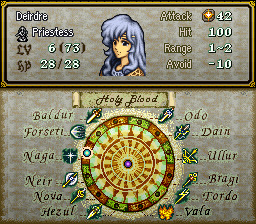
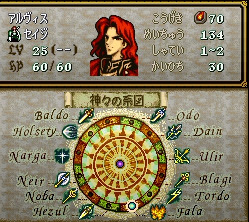
The result is twins--Julius has Major Loptous blood, and Loptous takes control of him accordingly. But Julia's Holy Blood wheel is missing that center circle--she does not exhibit Major OR Minor Loptous traits. If we're going to cast Holy blood as a matter of Mendelian genetics, how can she not have any Loptous blood?
The answer lies in the fact that Deirdre, in addition to her Minor Loptous, had Major Naga blood. We'll call the Naga alleles N and n.
Let's do a dihybrid cross.

This Punnett square is a little complicated. Arvis' full genotype is Llff (Minor Loptous, Major Fjalar). Deirdre's is Llnn (Minor Loptous, Major Naga). Their children therefore receive three sets of Holy blood alleles: Fjalar from Arvis, Naga from Deirdre, and Loptous from both. Arvis passes a Fjalar allele to both children, which makes sense if he is a homozygote. But the twins are each missing something they should have. Julius has no Naga blood, despite the fact that Deirdre must have given him an n allele. Likewise, Julia has no Loptous. Why are the twins missing two bloodlines that they must have inherited?
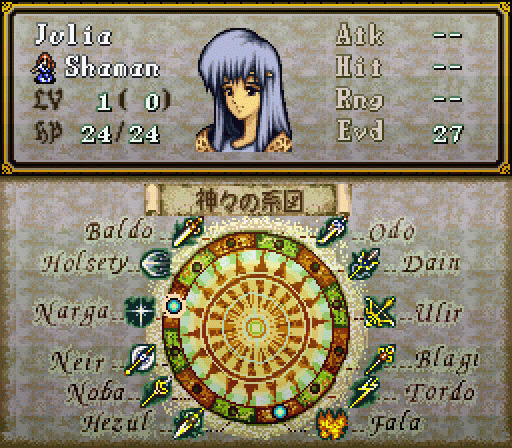
I'll dip back into Genealogy lore to explain this. Naga is the dragon of the holy element--in fact, in any Fire Emblem game set in this continuity, Naga is THE Holy Dragon who opposes whatever dark dragon is oppressing humanity this week. Naga's tome has a critical advantage when wielded against Loptous'. It stands to reason that the Naga allele would have a similar effect on the Loptous allele.
Because Deirdre was heterozygous for Loptous, with copies of the Major and Minor allele, her double n allele was not able to totally mask them and she showed a Minor Loptous phenotype. If Julia was a heterozygote, this would be the case for her as well. But if she is homozygous dominant (LL), even a single allele for Major Naga (n) can mask the Minor Loptous phenotype. To Jugdrali understanding, it appears that she does not have any "Loptous blood" at all.
Julius' single copy of n, however, cannot mask the double l in his genotype--in fact, the double recessive overwhelms the single recessive Naga allele, leaving him without the Naga phenotype at all. (Just as Julia wielding Naga always beats Julius wielding Loptous, but two Juliuses at once could overwhelm her.) The strength of the two opposing alleles also partly masks the effect of the Fjalar allele--so although both children have a copy of the recessive gene, its expression is indistinguishable from the expression of Minor blood.
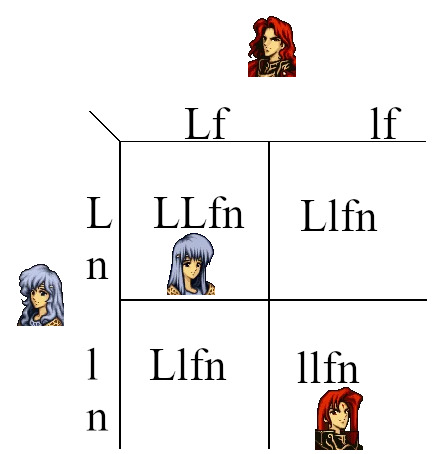
But having seen a cross where there are only single copies of alleles in the potential offspring, this makes difficulties when predicting genotypes for the F1 generation (that is, the Generation 2 children). In Punnett square exercises, even dihybrid crosses, it's assumed that you're getting the same type of alleles with any set of parents. This is not the case for Holy blood, where you have a dozen alleles all being crossed together. Thus, the F1 generation are mostly hemizygotes--individuals with only one copy of a certain allele. How could each generation have Major phenotypes when most parental crosses can only donate one Holy allele?
It's important, then, to note two things. Dominant and recessive alleles may not be dominant or recessive to alleles of other types, so the Holy blood alleles may have different effects on each other than they do with themselves. The second thing is that this is mystical dragon DNA, conferred to human carriers with a very deliberate intent, and as such it will sometimes behave in odd ways.
Let's see how this plays out with Quan and Ethlyn's children. Quan has the Major Njorun phenotype, so we'll assume him to be homozygous recessive (nj nj). Ethlyn is Minor Baldr. We'll assume her to be homozygous dominant (BrBr).

Leif and Altena have identical genotypes, but different phenotypes. Within chromosomes, some alleles can mask--partly or fully--related alleles. When we're dealing with mystical alleles, it's plausible that alleles could interact with each other across individuals--that as the elder child, Altena's copy of nj is suppressing the Major phenotype in anyone else with a single copy of nj born in her generation. (This would also guard against loads of Major-phenotype children brawling with each other over Holy weapons and inheritance.)
We can also assume that singular copies of an allele have, say, a 50% chance to be expressed once the first scion is born. Brigid and Edain are identical twins with Major and Minor Ullur, respectively. Assuming Lord Ring was uu, and both his wives lacked U or u (we will call this lack of allele z), their half-brother Andrey should also carry u. But he lacks the Minor phenotype. Therefore, the u he is carrying simply does not express itself phenotypically. We will say that there is a 50% chance of a single allele expressing a phenotype.
We're not done yet. What about crosses with parents who lack Holy blood, and crosses where both have the same Holy blood?
Let's start with Brigid. We already established that Brigid must be a hemizygote for u. If she is paired with Jamke, who has no Holy blood, their first child--Febail--always has the Major phenotype, because the dragons who blessed the Crusadors wanted those lines to have the full force of that blessing. Their subsequent children have a 50% chance of having no Holy blood. Patty always does, because of gameplay mechanics, but if you want to get more complex, you could say that Holy alleles always shows up in the first TWO scions, and reverts to normal Mendelian probability after that. The same applies to Edain's children, but hers will never have the Major phenotype due to cross-individual allele masking from Febail.

(Note that while Jamke's genotype is labeled as zz, this is not a real allele, just a placeholder denoting his lack of one.)
Incidentally, this also would apply to Seliph. Deirdre must have given him one Loptous allele, but it is being fully masked by her Naga allele; like Julia, he does not have any Loptrian traits. He is also a hemizygote for Major Baldr (br) and expresses the Major phenotype. In a cross between Seliph and Tine (a Thrud hemizygote, T), their children have the potential genotypes of brT, nT, lT--a 1/3 chance of Loptous. However, because Seliph is also the inheritor of Major Baldr, his br allele will likely be the one that appears in his children thanks to magic DNA sorting. So his children are safe. Julia's Naga allele will also insist on appearing in the genotype of her potential children.

Cross-individual genetic influence can, however, be overridden if you cross two parents who are heterozygous for the same Holy blood. The game tells us with a big ol' wink that you're definitely not supposed to do that because it's big taboo, but if you do, you'll get kids with Major blood. And there are two crosses you can do for this within your army: Ayra x Chulainn and Silvia x Claud. Both pairings are distant cousins.
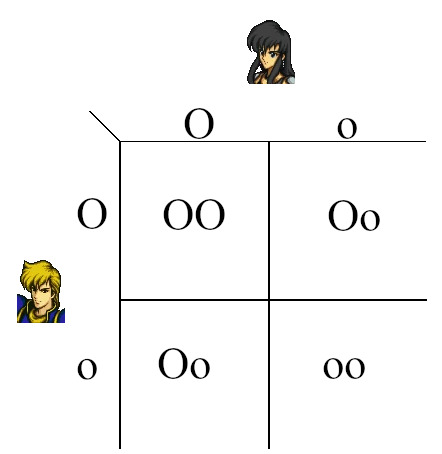
Assuming both are heterozygous for Od, that gives a 25% chance of an oo child. Although Shannan's two copies of o could mask a single copy in someone else, they cannot mask another double o--so even though Shannan is the Major Od homozygote in Generation 2, Larcei and Scathach are both able to become Major homozygotes as well through luck.
With the potential for children with one copy of the allele to be Major, Minor, or Neither, this also introduces the prospect that Holy blood alleles could be lost. We have two ways to handle this. One is to say that Holy blood alleles, being mystical, always end up in any offspring--so even if Febail has eight children with a non-carrier mother, all of them will have u in their genome. The other is to say that maybe that is just what happens sometimes. All Holy blood families are nobility of one rank or another, and they would simply add "Holy blood" to their matchmaking considerations alongside money, titles, and land. (There is also likely some amount of cheating going on with the "no marriages between the same type of Holy blood". Not enough to produce lots of Major children, but enough marriages between cousins to ensure that there are heterozygotes around to keep the Major and Minor alleles at a pretty high frequency within the family.)
The upheaval caused by the twenty-year Holy War scattered many scions of Holy blood all around the continent, and many subsequently married without regard to maintaining the Holy lineage. Under these circumstances, those rare alleles would eventually be lost through natural causes. Although Naga's alleles still exist by the time of Chrom, Naga has made multiple interventions into human affairs, and her assistance to Ylisse's first Exalt likely took the same form as her blessing to Heim, the progenitor of Jugdral's line of Naga blood.
So there we have it, a Mendelian explanation of how the inheritance of magic dragon traits works in a video game from 1996, thank you for reading it if you got this far.
9 notes
·
View notes